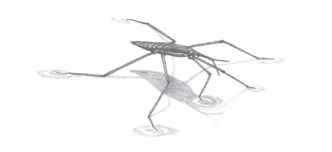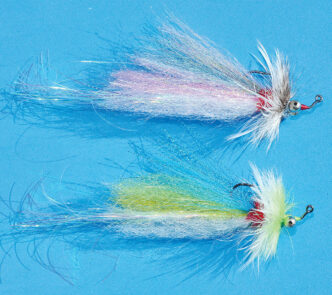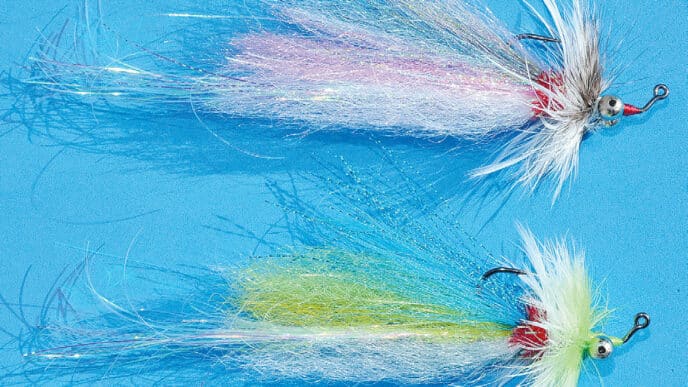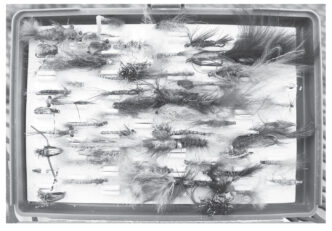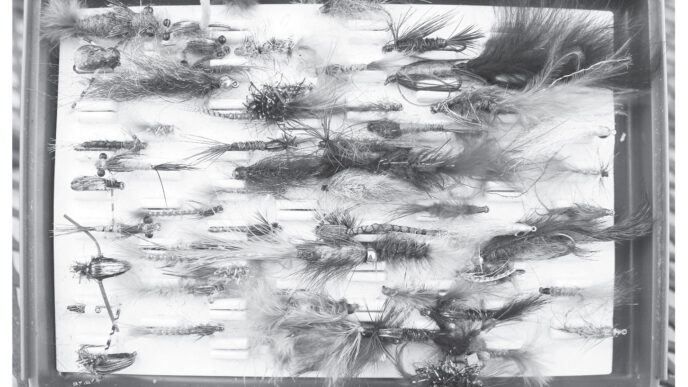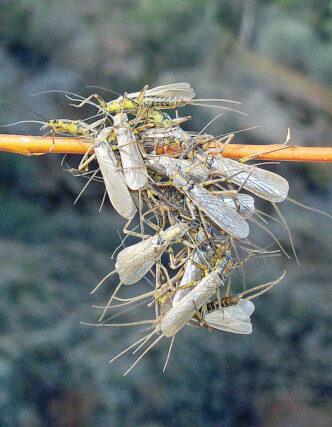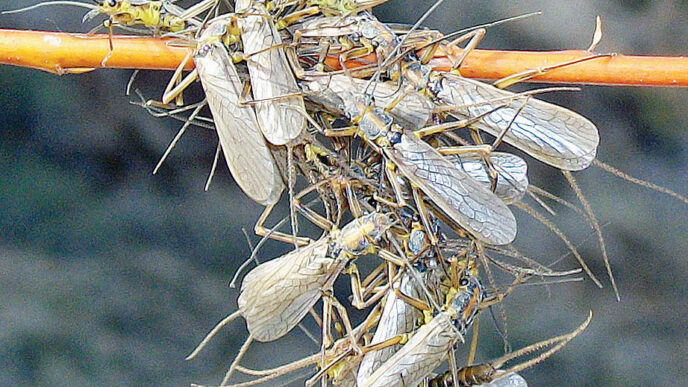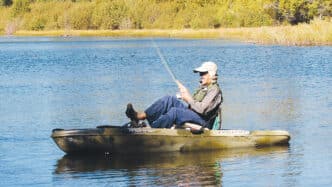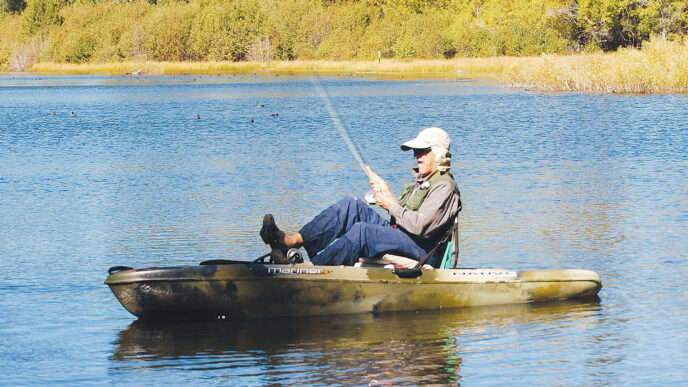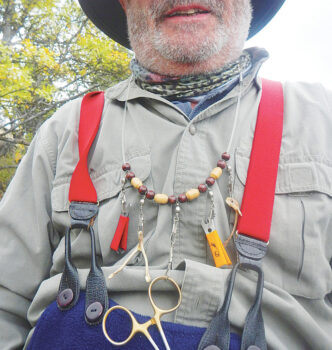How does a whirligig gig or a water strider stride? Why do male mayflies carry twice as much fat as females? When does water become a mineral? Does anyone really care? You, being a fly fisher, are probably among the few who would pursue such trivia, because after all, isn’t catch-and-release fly fishing the most trivial pursuit of them all?
John Voelker (aka Robert Traver) wrote in Testament of a Fisherman, “I fish . . . not because I regard fishing as being so terribly important but because I suspect that so many of the other concerns of men are equally unimportant — and not nearly so much fun.”
If you’ve read any of Voelker’s books or watched the Academy Award–winning adaptation of his Anatomy of a Murder, it quickly becomes apparent that he was obsessive about gathering apparent trivia and creating a picture much bigger than the sum of its trivial parts. Voelker’s success as a lawyer and his ultimate ascension to the Michigan Supreme Court bench was in no small way due to his fascination with small and apparently unrelated details. By all accounts, he was a fabulous fly fisher for the same reason. Having learned that, now you have an excuse for “wasting” time on the small stuff.
How’s this for small stuff? Water is a molecule. It has a negatively charged oxygen atom on one end and two positively charged hydrogen atoms at the other end. (When I say “end,” I’m speaking figuratively, because it’s a little more complicated than that.) Having both a negative and positive side is considered being bipolar, and for water, being bipolar is a good thing. The oxygen atom bonds to the hydrogen atoms of its nearest water molecule neighbor, while the hydrogen bonds with the oxygen on the water molecule at its other end. The result is a densely woven and nearly incompressible medium. As water cools, the bonds between the molecules get stronger, and the water grows increasingly dense until it falls to around 39 degrees Fahrenheit, when the bonds start to loosen up, and the water gets less and less dense until it finally freezes. Ice floats because the molecular bonds realign themselves and trap air. Ice is a mineral; liquid water is not. Trout, aquatic bugs, and fly fishers exploit the unique characteristics of the water molecule. Water is attracted to stuff that has a mild electric charge. Silica gel carries a charge, and water wants to bond with it. Silica is naturally “hydrophilic” (water-loving), and silica powder desiccant literally sucks the water out of your soggy fly because of its slight electrical charge. Items that have no charge are repelled by water. Chemists can neutralize the electrical charge of silica so it wants nothing to do with water. It then is called “hydrophobic” (water-hating). Put some uncharged silica on a fly, dunk it in the river, and it will literally push the water away, drive the fly to the surface, and make it float. If you hold the fly under the surface, the hydrophobic silica will aggressively push the water away and encase your fly in a shiny bubble that trout can’t resist.
If you mix the two kinds of silica and shake your soggy fly in it, the powder will both suck the water out of the fly and give it a nice coating of hydrophobic dust. You can spend $12.00 on a 25-gram bottle of premixed “shake,” or you can buy a pound of hydrophilic fumed silica (used for drying flowers) for $5.00 and drop another $8.00 for a quart of hydrophobic colloidal silica used for thickening resins. Mix the silica powders in any ratio you like, but please don’t huff the dust. Long-term, chronic exposure (like 20 years or more) can cause a nasty disease known as silicosis. For thirteen dollars, you’ll have enough “shake” to satisfy an entire fly club.
Mayfly nymphs have thin, positively charged exoskeletons that pull water into the membranes so that carbon dioxide inside the nymph can be exchanged for dissolved oxygen from the water. During the hatching process, the nymph splits open to reveal a neutrally charged dun that repels water. The waxy exoskeleton allows the dun to pop to the surface and float, even if it hatches deep underwater or gets submerged by a wave. When the dun molts into the spinner form, the hydrophobic exoskeleton is replaced by a hydrophilic one that allows the female mayfly to dap its abdomen through the film as she deposits her eggs.
Before the spinner lays her eggs, she needs to mate. The male spinners create clouds as they bob up and down and weave to and fro in their mating flight. They might do this for several hours, all the while releasing enticing pheromones to attract the females from their hiding spots in streamside vegetation. When a female has been suitably seduced, she will flit out to the male, mate, then commence egg-laying. The mating flight of the male mayflies burns tons of energy, while the female uses hardly any at all. This is why male mayflies are born bursting at the seams with energy-rich fat, while the females are svelte.
Whirligigs are hypnotic. These little aquatic beetles gather in clusters and race around like bumper cars at the Santa Cruz Boardwalk. The effect is so confusing that predators have a difficult time selecting one beetle from the crowd. As if this wasn’t enough to protect the whirligigs, they also exude a defensive musk that smells like ripe apples (hence their common name, apple bugs). Apparently, fish find the smell highly repugnant. Perhaps you might not want to include apples in your streamside lunch if you want fish to like the smell of your flies. If you want to attract whirligigs, put a stick of Juicy Fruit gum in the water. Juicy Fruit imitates the aggregation pheromones that whirligigs release to keep their buddies from getting lost.
Despite the seeming chaos of dancing whirligigs, they never crash into one another. Whirligigs navigate by pushing out minute waves, then feel for the reflection of these waves as the waves bounce off food, rocks, and other whirligigs. For all their speed (up to a yard per second), whirligigs expend very little energy getting from A to B. Instead of swimming, they exude a soaplike fluid behind themselves that disrupts the electrical bonds between the water molecules. With the bugs released from the surface tension pulling from behind, the surface tension of the water in front of the bug sucks them forward. All the whirligig has to do is steer with its rudderlike legs. Whirligigs are the only insects that live in the film. They sport two pair of eyes, one pair below the water and the other above. With these well-developed eyes, whirligigs can spy predators or prey in either realm.
Gigs are whirly,
Cues are curly,
And the dew is pearly early.
— James Thurber
In habitats supporting whirligigs, we can expect to find those nimble targets favored by rock-throwing boys: water striders. Water striders are covered with dense, hydrophobic hairs that allow them to skate across a tiny film of air between themselves and the water. Their widespread legs disperse their weight and are supported by surface tension. When they row, they push down and backward with their two middle legs, which creates a miniature wave. They immediately extend hydrophilic claws, which are drawn into the film and push against the crest of the wave to propel themselves forward. The rear legs act as rudders and steer the bug. In a fair race, they are even faster than whirligigs.
Water molecules may be small, but water is pretty neat stuff and is outclassed only by the creative adaptations its inhabitants have developed to exploit its unique properties.



